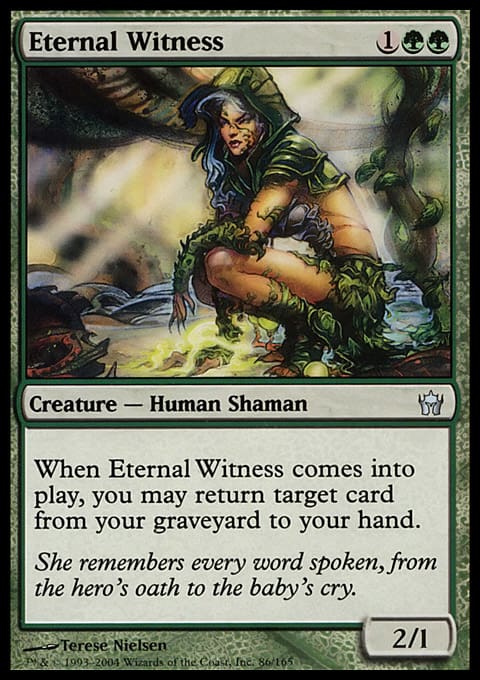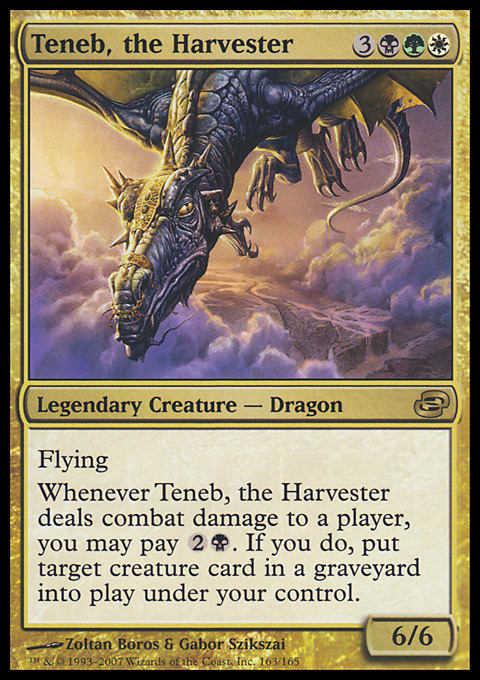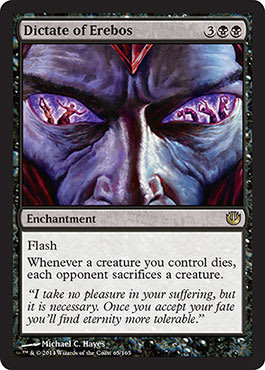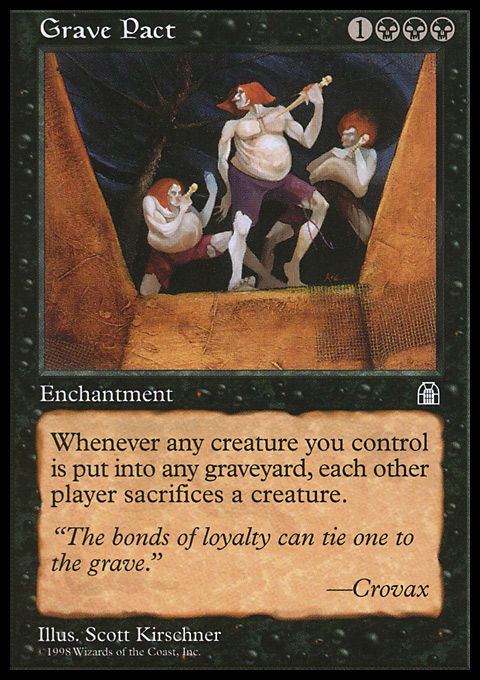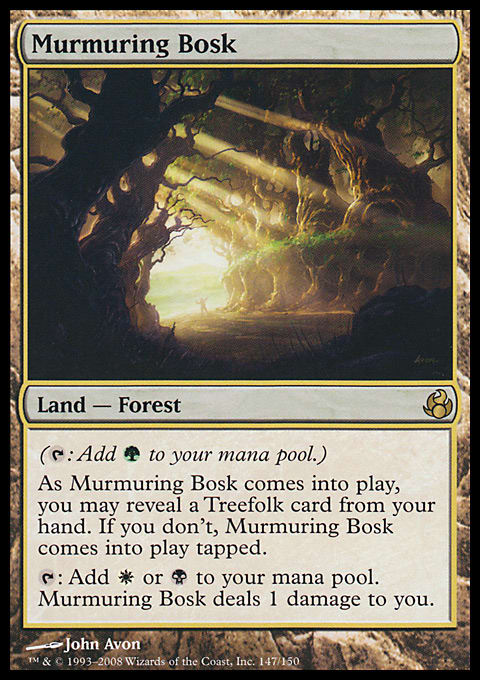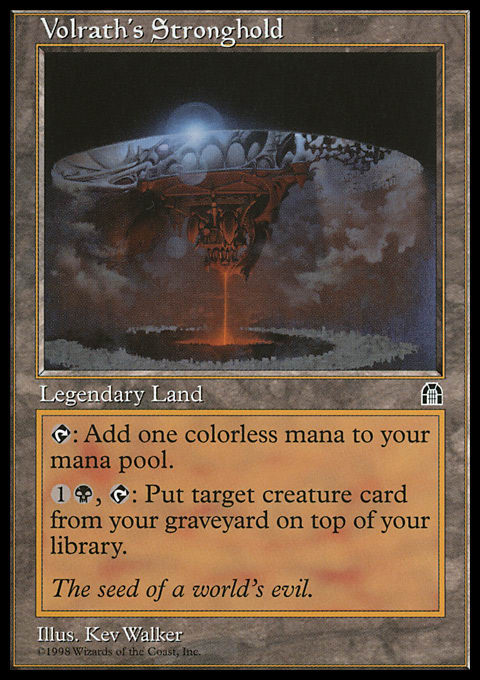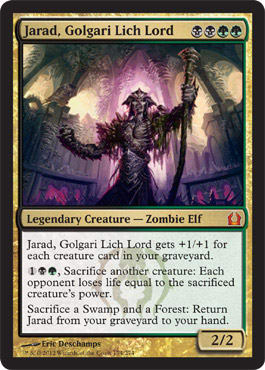You know what one of my favorite things in Magic is?
It’s seeing the progression of a deck you’re working on and watching it come to life. It all builds up to that sweet moment when you slot in that last card and say, “It’s finally done.”
But the best thing is that the fun never stops there!
Decks are creations that are always evolving, changing, and, ultimately, improving. I’m sure I speak for many to say that Commander decks are prime examples of this. As someone who loves building decks, I can say Commander is a format that gives you so much freedom in your decks, and even though archetypes are similar, the card choices between two people can be vastly different.
A sacrifice-and-recursion (“sac and recur”) strategy is something I’ve always wanted to try in Magic. I attempted it in Standard a while ago, but it never panned out, and even now, there’s only so much you can do in the format for strategies that interact with the graveyard. Thankfully, Commander allows you to use almost any card you want, so it opens up many different possibilities for decks.
As with any deck, it’s best to start with choosing your commander.
When deciding what commander to use, I needed someone who would give me a good color palette and was strong enough to support the overall deck’s strategy. Additionally, I wasn’t planning on building any game-ending combos specifically around my commander, so being able to win without the commander in play was something to keep in mind.
Alas, I fell upon the wings of Teneb, the Harvester.
B/G/W, more commonly known as “Junk,” is not only one of my favorite color combinations, it provides a great foundation for a deck based on sacrificing creatures.
Green comes with some of the fattest creatures, and since it’s a heavy creature color, there are many enters-the-battlefield effects available to us. It also has the best ways to ramp, which is very important since this deck wants its board state set up before everyone else’s.
Black brings the sacrifice outlets and graveyard-recursion effects—plus all that juicy removal to keep our opponents’ boards nice and clean. There’s also just enough life-gain in the deck to support cards that use life as a resource to draw cards or retrieve things from the graveyard.
White has more removal and also ways of locking down the board. The deck needs some time to set up, so being able to slow down opponents ensures we can get the sacrifice train moving. Similar to green, white gives us access to some great enters-the-battlefield creatures, such as Sun Titan and Angel of Despair, to further our game plan.
Browsing through other decklists, I noticed that everyone was playing Grave Pact.
But that’s it.
This sort of surprised me because there was a particular card from Journey into Nyx that I thought would be great alongside Grave Pact, but I didn’t find it in the majority of lists I looked at.
What’s better than one Grave Pact? Two Grave Pacts.
Because forcing opponents to sacrifice their creatures is such a strong effect in Commander, I wanted it to be one of the main strategies in the deck, and I wanted to approach the game with a mindset that’s almost control. Having more cards similar to Grave Pact makes it easier to draw the effect, but if we happen to have two or three of the cards in play, opponents can wave goodbye to their creatures since we’ll always end up at least two-for-one’ing them when we sacrifice our own. The flash on Dictate of Erebos is a nice bonus, and in some circumstances, it may be easier to cast than Grave Pact due to the lack of
More creatures in our opponents’ graveyards also results in more targets for Teneb, the Harvester. While we don’t need him in play to win, once he’s out, he should have plenty of things to steal.
The main thing to prioritize when building this deck was to include enough creatures to make use out of the Grave Pact effects without losing value when we sacrifice them. Since we’re sacrificing and reusing cards, the best creatures to use would have enters-the-battlefield effects or additional triggers upon dying. The deck also would not be an aggressive one, meaning defensive cards such as Ghostly Prison and Aura of Silence are perfect for slowing down everyone else and for making us less of a target while we hit our land drops and ramp.
Here’s the list I came up with:
Sac Attack ? Commander | Michael Yee
- Commander (0)
- Creatures (28)
- 1 Angel of Despair
- 1 Apprentice Necromancer
- 1 Birds of Paradise
- 1 Butcher of Malakir
- 1 Champion of Stray Souls
- 1 Creakwood Liege
- 1 Dauntless Escort
- 1 Disciple of Bolas
- 1 Eternal Witness
- 1 Fauna Shaman
- 1 Massacre Wurm
- 1 Pharika's Mender
- 1 Qasali Pridemage
- 1 Reaper of the Wilds
- 1 Sakura-Tribe Elder
- 1 Soul of the Harvest
- 1 Sun Titan
- 1 Wood Elves
- 1 Woodfall Primus
- 1 Worldspine Wurm
- 1 Burnished Hart
- 1 Ashling, the Extinguisher
- 1 Athreos, God of Passage
- 1 Jarad, Golgari Lich Lord
- 1 Kokusho, the Evening Star
- 1 Saffi Eriksdotter
- 1 Savra, Queen of the Golgari
- 1 Sheoldred, Whispering One
- Spells (33)
- 1 Eladamri's Call
- 1 Grim Return
- 1 Putrefy
- 1 Worldly Tutor
- 1 Altar of Bone
- 1 Crime // Punishment
- 1 Cultivate
- 1 Diabolic Intent
- 1 Diabolic Tutor
- 1 Harmonize
- 1 Natural Order
- 1 Nature's Lore
- 1 Nostalgic Dreams
- 1 Skyshroud Claim
- 1 Toxic Deluge
- 1 Wrath of God
- 1 Attrition
- 1 Aura of Silence
- 1 Aura Shards
- 1 Dictate of Erebos
- 1 Fanatical Devotion
- 1 Feed the Pack
- 1 Ghostly Prison
- 1 Golgari Germination
- 1 Grave Pact
- 1 Greater Good
- 1 Lurking Predators
- 1 Phyrexian Arena
- 1 Phyrexian Reclamation
- 1 Primeval Bounty
- 1 Chromatic Lantern
- 1 Lightning Greaves
- 1 Sol Ring
- Lands (38)
- 3 Plains
- 5 Swamp
- 7 Forest
- 1 Command Tower
- 1 Evolving Wilds
- 1 Godless Shrine
- 1 Graypelt Refuge
- 1 Homeward Path
- 1 Isolated Chapel
- 1 Jund Panorama
- 1 Kabira Crossroads
- 1 Murmuring Bosk
- 1 Overgrown Tomb
- 1 Rogue's Passage
- 1 Sunpetal Grove
- 1 Tainted Field
- 1 Tainted Wood
- 1 Temple Garden
- 1 Temple of Malady
- 1 Temple of Plenty
- 1 Temple of Silence
- 1 Kor Haven
- 1 Miren, the Moaning Well
- 1 Volrath's Stronghold
- 1 Woodland Cemetery
- 1 Yavimaya Hollow
Ramp and Fix
Even though some of the mana-fixers and rampers I’m using (Nature's Lore and Skyshroud Claim for example) only fetch Forests, the majority of our deck is green, so that works out fine because we’re still able to fetch things like shock lands and Murmuring Bosk with them.
Being able to use creatures to ramp in the early game and then sacrifice them later on is a good way to hold value in all stages of the game, which is why cards like Birds of Paradise and Wood Elves are in the list.
The deck doesn’t have a focus on artifacts, but Burnished Hart has a low cost and is an effective creature to ramp with that also triggering Grave Pact–type cards. Chromatic Lantern makes mana-fixing simple, and Sol Ring is your run-of-the-mill artifact ramp.
Eye for an Eye
Grave Pact and Dictate of Erebos are the center of the deck, so bringing them out as soon as possible is ideal. We have plenty of tutors for that, and even though we have some that only grab creatures, Butcher of Malakir acts as a third Grave Pact with the benefit of being a creature, allowing us to use cards such as Worldly Tutor to grab him.
Once we have the sacrifice train going, we can focus on other things. Whether it’s sacrificing Qasali Pridemage to kill an enchantment or an artifact or killing off a creature with Greater Good to draw some cards, we’re whittling down our opponents’ boards. By having a lot of ways to force our opponents to sacrifice creatures, we avoid defensive effects and abilities such as shroud, indestructible, hexproof, and protection.
The downside, of course, is we can’t always choose what creatures are removed, but with the number of ways we can force sacrifices, it shouldn’t be too much of a problem. If worst comes to worst, we have spot removal through cards such as Angel of Despair and Putrefy.
Mass-token-production or a lot of weenies are our biggest problems, but cards like Toxic Deluge, Wrath of God, and Massacre Wurm help against those strategies. Especially in combination with Grave Pact effects, our partial and selective Wraths can turn into full-blown board wipes.
Bringing Them Back
Recursion is an important feature of any Commander deck, and if we’re going to be sacrificing the majority of our creatures, we need ways of returning them to our hand or the battlefield after they’re dead and gone.
Phyrexian Reclamation and Volrath's Stronghold are some of our best permanents that do this. They’re low-cost and efficient ways of retrieving creatures. Cards like Pharika's Mender and Sheoldred, Whispering One let us have the same effect with the addition of a body. Dispersing this ability across different types of cards is ideal since every deck carries removal for a variety of things. Keeping things spread out makes it more difficult for our opponents to stop us from bringing back the dead.
Because we have both Grave Pact effects and graveyard retrieval, the deck works almost like a cycle. We sacrifice creatures to get rid of our opponents’ creatures, play more to return the previous ones, sacrifice those, and then rinse and repeat.
Of course, there’s more to the deck than that.
The Valuable Dead
Because we’re losing most of our creatures to tax our opponents’ boards, it’s best to make the most out of their sacrifices.
Attrition is among our best enchantments in the deck since we not only gain to have a reusable method of targeted removal, but it triggers Grave Pact effects at the same time. It only hits nonblack creatures, but it’s still a strong ability.
Jarad, Golgari Lich Lord is another proactive card to gain value off our sacrificial creatures. He is a good finisher, and in a multiplayer game, it hits every opponent, so it’s best to use him when you’re prepared to receive some heat on the way back, especially if you’re sacrificing a 15/15 Worldspine Wurm.
However, offensive cards aren’t the only things we have.
Reaper of the Wilds is awesome in this deck. It has a solid body to block and attack with, and thanks to its abilities, it has some staying power. The scry is what we’re after though, and since everything is going to be dying around us, you can be sure the top of our deck will be almost perfect.
Another newer card that works well in this list is Champion of Stray Souls. It’s a card that, sadly, didn’t see any Standard play, but because the games go on longer in Commander, we can do some mass-recursion later in the game thanks to the tokens we’ll have.
Speaking of tokens . . .
A Disposable Army
You’ll notice we have some token generators in the decklist. Not only can tokens be another win condition for us in this deck, but the ability to create tokens and use them as sacrifices is extremely valuable to our strategy. It lets us keep our more important creatures on board and also save cards such as Kokusho, the Evening Star or Dauntless Escort for when we really need them.
Primeval Bounty not only provides extra tokens when we cast creature spells, but it also helps us gain life and make our creatures larger. Golgari Germination is not as beneficial, but we can bring it into play earlier, and it gives additional value off all our nontoken sacrifices.
Creakwood Liege is one of our best token-related permanents. The B/G Worms it produces synergizes well with Savra, Queen of the Golgari, and not only does the Liege produce tokens for us, but it also pumps all of our creatures. Reaper of the Wilds and Pharika's Mender are just a couple of the cards that get the best of both worlds while Creakwood Liege is on the battlefield.
The deck is quite fun and involves a ton of board interaction. There are many different lines of play you can follow, and since we’re using quite a few tutors in the deck, there is a toolbox element to it as well. If you enjoy sacrificing creatures for a lot of value, wiping out your opponents’ boards, and making tokens, this deck might be for you!
Oh, and want to know another fun thing this deck can do? With the right opening hand, you can sneak in Worldspine Wurm on turn three with haste!
Scary.
- Michael Y.














